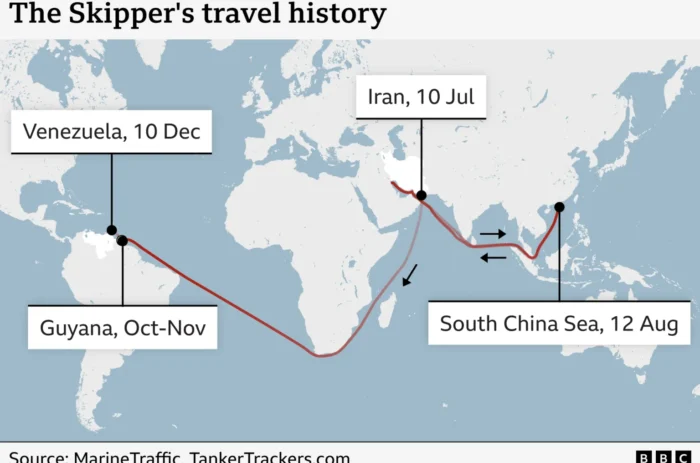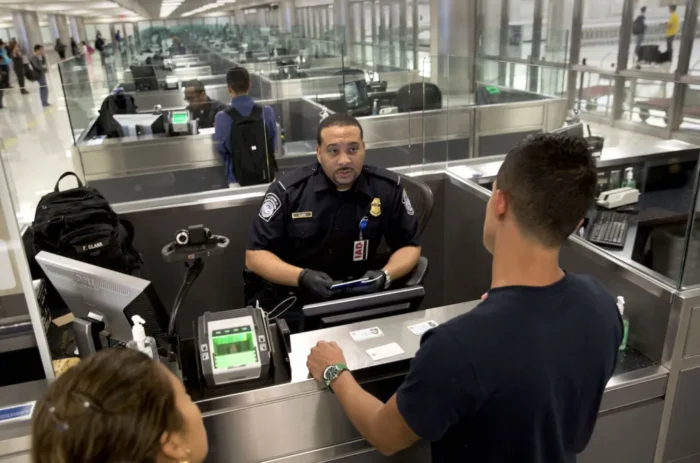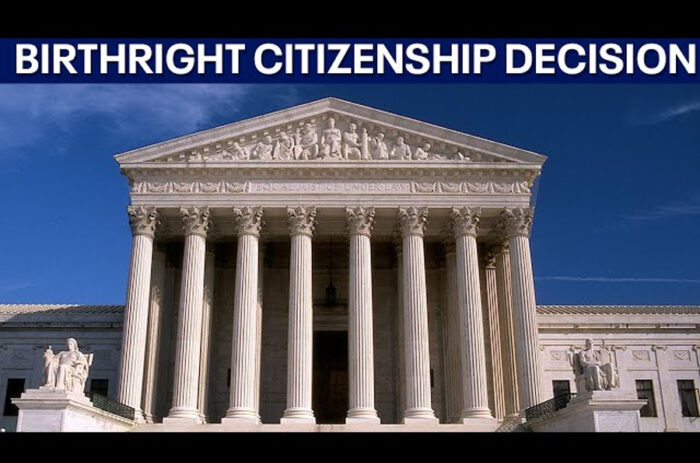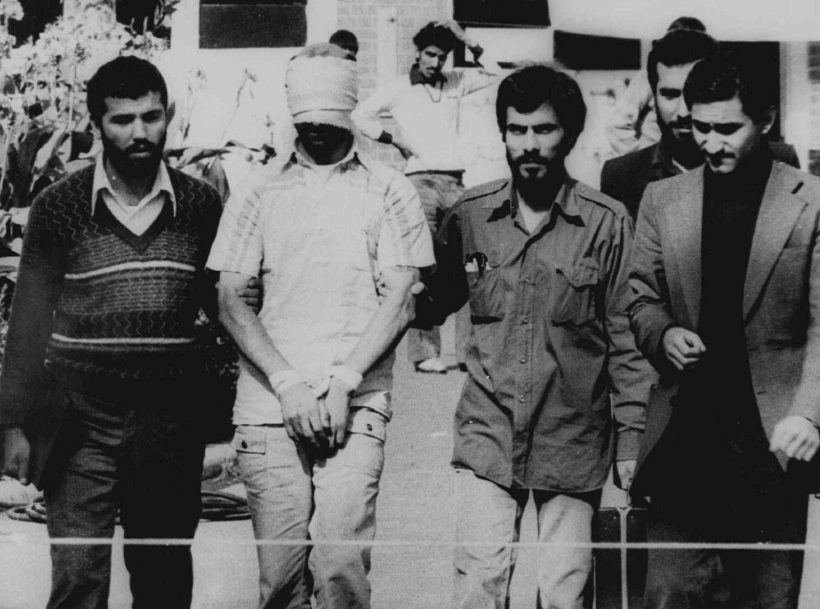
Nov. 9, 1979 - Photo one of the hostages seized when Islamic radicals stormed the U.S. Embassy in Iran. Blindfolded and with his hands bound, the hostage was displayed to a crowd in Tehran, Iran. (AP Photo, file)
redo Jump to...
print Print...
NOTE: The article below is an original Associated Press report from November 8, 1979:
A mob of Iranian “students” overran U.S. Marine guards in a three-hour struggle Sunday (Nov. 8, 1979) and invaded the American Embassy in Tehran, seizing dozens of staff members as hostages, Tehran Radio reported. They demanded that the United States send the exiled shah back to Iran for trial, the radio said.
No serious injuries were reported. Tehran Radio said as many as 100 hostages were being held, but an Iranian Foreign Ministry spokesman said he believed it was fewer than 45 — about 35 Americans and seven or eight Iranians.
The spokesman, reached in Tehran by telephone from New York, said an estimated 200 or 300 [so-called] students were involved.
In Washington, State Department spokesman Jack Touhy said it was estimated 59 persons were being held captive and there was no firm evidence the invaders were armed. He said a State Department working group was set up to monitor the situation and added the U.S. government would have no immediate comment on the demand that the shah be returned to Iran.
White House spokesman Alan Raymond reported in Washington that President Carter, spending the weekend at the Camp David retreat, was in contact with his national security adviser Zbigniew Brzezinski, Secretary of State Cyrus R. Vance and Defense Secretary Harold Brown.
The Tehran Radio broadcasts, monitored in London, said the embassy’s Marine guards hurled tear-gas canisters but were unable to hold back the waves of students. None of the broadcasts mentioned any weapons besides the tear gas.
Japan’s Kyodo News Service reported from Tehran that the invaders called a news conference in the embassy compound and a sweater-clad man in his mid-20s told reporters, “We will continue to stay here and won’t release any of the hostages until the United States returns the ousted shah, which is what the Iranian people want.”
There were reports that the hostages were blindfolded and handcuffed. The Foreign Ministry spokesman denied this, saying the embassy takeover was “a very peaceful exercise. They are dealing with them very nicely.”
But television film broadcast in some Western countries showed a few hostages in front of an embassy building who were blindfolded and either bound or handcuffed.
…The Foreign Ministry spokesman said…a Scandinavian ambassador in Tehran would act as a mediator “to try to convince the students to get out of the compound.” He reported an Iranian Moslem religious leader also was trying to talk the invaders into leaving.
The spokesman, who asked not to be named, said he was unsure of the identities of the two mediators.
The State Department said in Washington the Iranian government had “given assurances that our people being held are safe and well.”
Tehran Radio said the U.S. Marines and other “mercenaries” — not further identified — were safe in a room and “No violent action has been taken against them.”
An official at the British Embassy, reached by phone from London, said it appeared “as though the hostages are having to spend the night in the basement. There is no knowing how long they are going to be held.”
The Foreign Ministry spokesman said that after the takeover thousands of other Iranians converged on the spacious embassy compound, on a major avenue in central Tehran, and milled around outside, shouting anti-American slogans.
Just hours after the embassy invasion, seven demonstrators chained themselves inside the Statue of Liberty in New York Harbor to protest the ousted Shah Mohammad Reza Pahlavi’s presence in New York, where he is hospitalized for cancer treatment. After 3 1/2 hours authorities cut the chains and took them into custody.
Pahlavi went to New York last month on a special medical visa and underwent gallbladder surgery and testing. Doctors recommended he stay in the United States for six months to a year for drug treatment of his cancer. He fled Iran in January and later took up residence in Mexico.
The Tehran broadcasts, some not clearly received, said the students were motivated by a “message” from the leader of Iran’s Islamic Revolution, Ayatollah Ruhollah Khomeini.
The Iranian Embassy in Washington released a statement issued by the Foreign Ministry in Tehran after the takeover accusing the United States of engaging in an “imperialist plot” to reinstate the former monarch. Iranian officials have claimed the deposed ruler is faking illness.
“The action taken today by a group of our countrymen reflects the natural feeling of the Iranian nation towards the U.S. government’s disregard” of an official Iranian protest of Pahlavi’s presence in New York, the statement said.
It said the U.S. government ignored the protest and refused to allow two Iranian doctors living in the United States to examine the shah, who could have been treated in Mexico or another country.
“The people of Iran were extremely concerned about any relocation and activities of the shah and … would consider the shah’s illness a pretext for his going to the United States in order to have access to better activities against the Islamic Revolution in Iran,” the statement said.
State Department spokesman Touhy said the U.S. charge d’affaires in Tehran, Bruce Laingen, and two other American officials were at the Foreign Ministry at the time the embassy was seized, and had contacted Iranian Foreign Minister Ibrahim Yazdi. No U.S. ambassador currently is assigned to Tehran.
Touhy said Laingen remained at the ministry, negotiating with officials there, and negotiations were not being conducted with the embassy invaders. He said families of U.S. personnel held in the embassy were being advised that the hostages had not been harmed. He did not release any names of the Americans.
The State Department had issued a statement earlier, saying Laingen “had been given assurances by the Iranian government that it will do its best to resolve the matter satisfactorily. We appreciate the efforts of the Iranian government.”
This was the second time the embassy has been taken over since the revolution. Gunmen believed to be renegade revolutionaries invaded the embassy last Feb. 14, killing one Iranian and taking 101 hostages, including Ambassador William Sullivan and 19 Marine guards. Pro-Khomeini forces drove the insurgents from the badly damaged compound after 3 1/2 hours.
A Baghdad Radio broadcast reported that Iraq had lodged a strong protest with Iran over what was described as an attack on the Iraqi Embassy in Tehran Saturday and the abduction of four persons. The Khomeini regime accuses Iraq of aiding autonomy-seeking minorities in Iran.
Originally published on November 8, 1979 by the Associated Press. Reprinted here for educational purposes only. May not be reproduced on other websites without permission from the Associated Press.
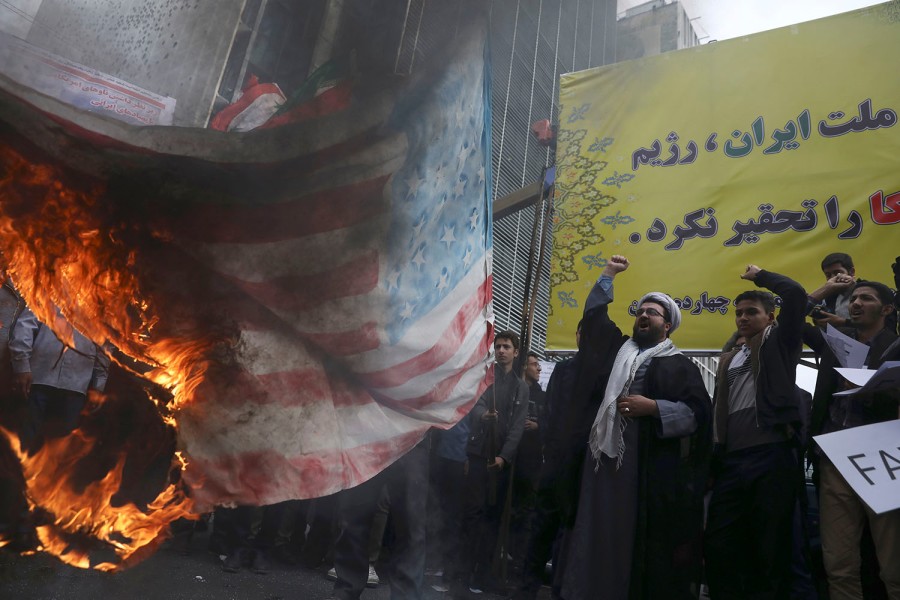
Iranian demonstrators chant slogans as they set fire to a makeshift U.S. flag during an annual rally in front of the former U.S. Embassy in Tehran, Iran, Monday, Nov. 4, 2019. Reviving decades-old cries of “Death to America,” Iran on Monday marked the 40th anniversary of the 1979 takeover of the U.S. Embassy in Tehran. (Vahid Salemi/Associated Press)
Questions
1. For IRAN, give the following information:
- capital
- location/the countries that share its borders
- the religious breakdown of the population
- the type of government
- the chief of state (and head of government if different) If monarch or dictator, since what date has he/she ruled? – include name of heir apparent for monarch
- the population
Find the answers at the CIA World FactBook website. For each country, answers can be found under the “Geography” “People” and “Government” headings.
NOTE: Before answering the following questions, read the info under “Background” and watch the video under “Resources” below.
2. For IRAN:
a) list the who, what, where and when of the news item
b) What were the students demanding?
c) What did President Jimmy Carter do when he heard the news?
d) How did the Iranian Foreign Ministry spokesman describe the embassy takeover?
e) How did news reports contradict the spokesman’s claims?
f) President Carter’s refusal to consider any military action or force to rescue our hostages was made public. Do you think that information should have been made public? Explain your answer.
g) U.S. citizens were held by the Iranian militants for over a year – 444 days. Ask a parent or a grandparent what he/she remembers about the Iranian hostage crisis.
h) Republican Ronald Reagan beat Democrat Jimmy Carter in the November 1980 election.
Per wikipedia: The Algiers Accords negotiated between November 1980 and Jan 1981 called for Iran’s immediate freeing of the hostages, the unfreezing of $7.9 billion of Iranian assets and immunity from lawsuits Iran might have faced in America, and a pledge by the United States that “it is and from now on will be the policy of the United States not to intervene, directly or indirectly, politically or militarily, in Iran’s internal affairs.” (For Iran’s part, it had to deposit $1 billion in an escrow account to satisfy claims adjudicated by the Tribunal in favor of American businesses that had lost assets after the hostage takeover.)
Regarding Iran’s decision to release the hostages on Reagan’s inauguration day, Michael Rubin wrote in a commentary that Iran’s “Supreme Leader” Ayatollah Khomeini “rejected substantive engagement for more than a year, until it became clear that Ronald Reagan would be the next president. …as Ted Cruz and Marco Rubio implied, Khomeini was willing to strike an accord with Carter because Khomeini thought that he could extract a far greater price from a weak Carter than a stronger Reagan.
Ask a parent: do you agree with Mr. Rubin? Please explain your answer.
Background
How American citizens taken hostage in Iran were treated by their captors:
The most terrifying night for the hostages came on February 5, 1980, when guards in black ski masks roused the 52 hostages from their sleep and led them blindfolded to other rooms. They were searched after being ordered to strip themselves until they were bare, and to keep their hands up. They were then told to kneel down. “This was the greatest moment” as one hostage said. They were still wearing the blindfolds, so naturally, they were terrified even further. One of the hostages later recalled ‘It was an embarrassing moment. However, we were too scared to realize it.’ The mock execution ended after the guards cocked their weapons and readied them to fire but finally ejected their rounds and told the prisoners to wear their clothes again. The hostages were later told the exercise was “just a joke” and something the guards “had wanted to do”. However, this affected a lot of the hostages long after.
Michael Metrinko was kept in solitary confinement for months. On two occasions when he expressed his opinion of Ayatollah Khomeini and he was punished especially severely in relation to the ordinary mistreatment of the hostages – the first time being kept in handcuffs for 24 hours a day for two weeks, and being beaten and kept alone in a freezing cell for two weeks with a diet of bread and water the second time.
One hostage, U.S. Army medic Donald Hohman, went on a hunger strike for several weeks and two hostages are thought to have attempted suicide. Steve Lauterbach became despondent, broke a water glass and slashed his wrists after being locked in a dark basement room of the chancery with his hand tightly bound and aching badly. He was found by guards, rushed to the hospital and patched up.
Jerry Miele, an introverted CIA communicator technician, smashed his head into the corner of a door, knocking himself unconscious and cutting a deep gash from which blood poured. “Naturally withdrawn” and looking “ill, old, tired, and vulnerable”, Miele had become the butt of his guards’ jokes who rigged up a mock electric chair with wires to emphasize the fate that awaited him. After his fellow hostages applied first aid and raised alarm, he was taken to a hospital after a long delay created by the guards.
Different hostages described further Iranian threats to boil their feet in oil (Alan B. Golacinski), cut their eyes out (Rick Kupke), or kidnap and kill a disabled son in America and “start sending pieces of him to your wife”. (David Roeder)
Four different hostages attempted to escape all being punished with stretches of solitary confinement when their attempt was discovered.
The hostage released for multiple sclerosis, Richard Queen, first developed symptoms of dizziness and numbness in his arm six months before his release. It was misdiagnosed by Iranians first as a reaction to draft of cold air, and after warmer confinement didn’t help as “it’s nothing, it’s nothing”, the symptoms of which would soon disappear. Over the months the symptoms spread to his right side and worsened until Queen “was literally flat on his back unable to move without growing dizzy and throwing up.” He was held hostage for 250 days and released on July 11, 1980.
The cruelty of the Iranian prison guards became “a form of slow torture.” Guards would often withhold mail from home, telling one hostage, Charles W. Scott, “I don’t see anything for you, Mr. Scott. Are you sure your wife has not found another man?” and hostages’ possessions were stolen by their Iranian hostage takers.
As the hostages were taken to the plane that would fly them out of Tehran, they were led through a gauntlet of students forming parallel lines and shouting “Marg bar Amrika,” (death to America). When the pilot announced they were out of Iran the “freed hostages went wild with happiness. Shouting, cheering, crying, clapping, falling into one another’s arms.” (from wikipedia)
The Iranian Hostage Crisis:
In the wake of the 1979 Iranian Revolution (also called the Islamic Revolution), anti-American sentiment was widespread in Iran, and the staff at the U.S. embassy in Tehran, which at one time numbered more than 1,400, was reduced to a skeleton crew of roughly 70.
In February 1979, just weeks after ousted ruler the Shah of Iran (Mohammad Reza Shah Pahlavi) fled Iran, the U.S. embassy was besieged and briefly taken over by armed students. One Iranian embassy employee was killed, and a number of Americans were wounded. Iranian authorities assured the Americans that security around the embassy would be improved. President Jimmy Carter believed the militants and did not order American embassy personnel to come home at that time. However, as Britannica reports:
- In October 1979 the U.S. State Department was informed that the deposed Iranian monarch required medical treatment that his aides claimed was available only in the United States; U.S. authorities, in turn, informed the Iranian prime minister, Mehdi Bazargan, of the shah’s impending arrival on American soil.
- Bazargan, in light of the February attack, guaranteed the safety of the U.S. embassy and its staff.
- The shah arrived in New York City on October 22. The initial public response in Iran was moderate, but on November 4, 1979 the embassy was attacked by a mob of perhaps 3,000, some of whom were armed and who, after a short siege, took 63 American men and women hostage. (An additional three members of the U.S. diplomatic staff were actually seized at the Iranian Foreign Ministry.)
- Within the next few days, representatives of U.S. President Jimmy Carter and Tehran-based diplomats from other countries attempted but failed to free the hostages. An American delegation headed by former U.S. attorney general Ramsey Clark – who had long-standing relations with many Iranian officials – was refused admission to Iran.
- The U.S. responded by freezing Iranian assets and leveraging international support against the government in Tehran.
On November 17, 1979, Khomeini ordered the release of 13 hostages, but the remaining captives were the focus of intense diplomatic and military efforts. As Britannica describes:
- Almost from the beginning of the crisis, U.S. military forces started formulating plans to recover the hostages, and by early April 1980 the U.S. administration, still unable to find anyone to negotiate with in a meaningful fashion, was seeking a military option.
- Despite political turbulence in Iran, the hostages were still being held by their original captors in the embassy complex.
- On April 24 a small U.S. task force landed in the desert southeast of Tehrān. From that staging point, a group of special operations soldiers was to advance via helicopter to a second rally point, stage a quick raid of the embassy compound, and convey the hostages to an airstrip that was to be secured beforehand by a second team of soldiers, who were to fly there directly from outside Iran. The soldiers and hostages would then withdraw by air. However, the operation was fraught with problems from the beginning. Two of the eight helicopters sent for the operation malfunctioned before arriving at the first staging area, and another broke down on the site. Unable to complete their mission, U.S. forces sought to withdraw, during which one of the remaining helicopters collided with a support aircraft. Eight U.S. service members were killed, and their bodies, left behind, were later paraded before Iranian television cameras.
- The Carter administration, humiliated by the failed mission and loss of life, expended great energy to have the bodies returned to the United States. ….
- All diplomatic initiatives in the hostage crisis came to a standstill, and the hostages were placed, incommunicado, in new, concealed locations.
- A U.S. trade embargo, directed against Iran, followed, but it did little to resolve the diplomatic stalemate that the hostage crisis had become. The onset of hostilities with Iraq spurred the Iranians to return to the bargaining table, and indirect negotiations were carried out, with Algerian diplomats serving as back channel couriers for both sides.
- An agreement having been reached, the hostages were released on Jan. 20, 1981, just minutes after the inauguration of Pres. Ronald Reagan. The timing of the event [showed the world that the Iranians were concerned with what Reagan would do to get the hostages back when he took office. The hostages were released just as Reagan was inaugurated.] (from britannica.com)
Resources
Watch a video from Today in Georgia History (President Jimmy Carter, a Democrat, was from Georgia):
See photos at rferl.org.
Read a 2014 article: “Making Iran captor UN ambassador ‘like spitting on us’”
Read a 2013 article about then-President Obama’s unpopular nuclear deal with Iran: “Former hostages react to Iran’s nuclear deal”
Did you know U.S. sailors were briefly held captive by Iran in 2016? Read “Details on Iran’s abuse of US sailors remain classified” and “What’s missing from this story?”
Daily “Answers” emails are provided for Daily News Articles, Tuesday’s World Events and Friday’s News Quiz.
